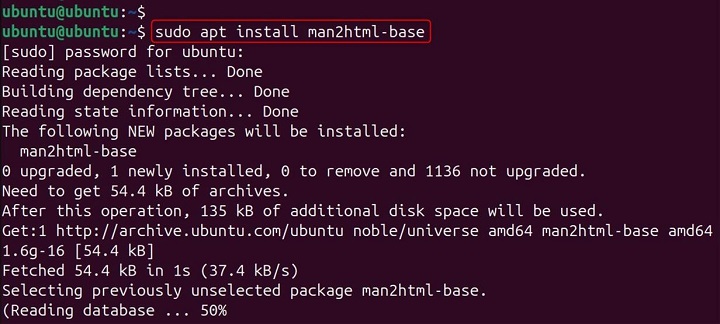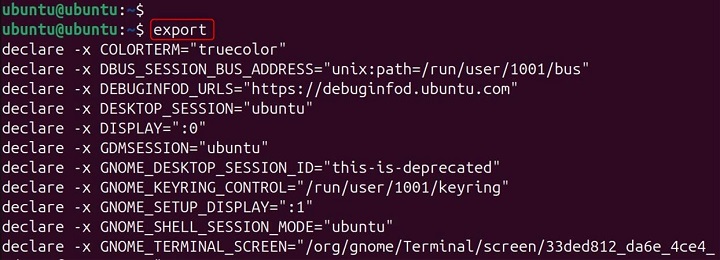
man2html Command in Linux
The man2html command in Linux is a powerful tool used to convert manual (man) pages into HTML format. This command is particularly useful for system administrators, developers, and anyone who needs to make man pages accessible via web browsers.
Table of Contents
Here is a comprehensive guide to the options available with the man2html command −
- Understanding man2html Command
- Syntax of man2html Command
- man2html Command Options
- Examples of man2html Command in Linux
Understanding man2html Command
The man2html command converts man pages, which are typically viewed in the terminal, into HTML format. This conversion allows you to view and share man pages in a web browser, making them more accessible and easier to navigate. The HTML format also enables the use of hyperlinks, which can enhance the usability of the documentation.
Let's install it −
sudo apt install man2html-base

Syntax of man2html Command
The basic syntax for the man2html command is −
man2html [options] [file]
Without any options, the command reads from standard input and writes to standard output.
man2html Command Options
Here are some of the most commonly used options with the man2html command −
| Options | Description |
|---|---|
| -p: | Specify the output file. |
| -M | Specify the man page directory. |
| -l | Generate a local file. |
| -c | Specify the CSS file. |
| -d | Specify the directory for output files. |
| -q | Quiet mode. Suppress all warnings and messages. |
| -v | Verbose mode. Display detailed information about the conversion process. |
| -h | Display help information. |
| -r | Generate relative links. |
| -H | Specify the HTML header file. |
| -T | Specify the HTML trailer file. |
Examples of man2html Command in Linux
Let's explore some practical examples to understand how to use the man2html command effectively. Let's explore some of these features with practical examples −
Convert a Man Page to HTML
This command converts the man page for the ls command into HTML format and saves it as ls.html. The man command is used to generate the man page, and the output is piped to man2html −
man ls | man2html > ls.html

Generate Relative Links
This command converts the man page for the ls command into HTML format with relative links and saves it as ls.html. The -r option generates relative links −
man ls | man2html -r > ls.html

Specify the HTML Header File
This command converts the man page for the ls command into HTML format and includes the specified HTML header file. The -H option specifies the header file −
man ls | man2html -H header.html > ls.html

Specify the HTML Trailer File
This command converts the man page for the ls command into HTML format and includes the specified HTML trailer file. The -T option specifies the trailer file −
man ls | man2html -T trailer.html > ls.html

Specify the Man Page Directory
This command converts the man page for the ls command located in the specified directory into HTML format and saves it as ls.html. The -M option specifies the man page directory −
man2html -M /usr/share/man ls.1 > ls.html

Specify the Output File
This command converts the man page for the ls command into HTML format and saves it as ls.html. The -p option specifies the output file −
man ls | man2html -p ls.html

Generate a Local File
This command converts the man page for the ls command into a local HTML file and saves it as ls.html. The -l option generates a local file −
man ls | man2html -l > ls.html

Specify the CSS File
This command converts the man page for the ls command into HTML format and applies the specified CSS file. The -c option specifies the CSS file −
man ls | man2html -c style.css > ls.html

Specify the Directory for Output Files
This command converts the man page for the ls command into HTML format and saves it in the specified directory. The -d option specifies the directory for output files −
man ls | man2html -d /path/to/output > ls.html

Quiet Mode
This command converts the man page for the ls command into HTML format in quiet mode, suppressing all warnings and messages. The -q option enables quiet mode −
man ls | man2html -q > ls.html

Verbose Mode
This command converts the man page for the ls command into HTML format in verbose mode, displaying detailed information about the conversion process. The -v option enables verbose mode −
man ls | man2html -v > ls.html

Batch Conversion
This script converts all man pages in the specified directory into HTML format and saves them in the output directory. The for loop iterates over each man page file and converts it using man2html −
for file in /usr/share/man/man1/*.1; do man2html -M /usr/share/man $file > /path/to/output/$(basename $file .1).html done
Customizing the HTML Output
This command converts the man page for the ls command into HTML format with a custom header, trailer, and CSS file. The -H, -T, and -c options specify the custom files −
man ls | man2html -H custom_header.html -T custom_trailer.html -c custom_style.css > ls.html

Integrating with Web Servers
This command converts the man page for the ls command into HTML format and saves it in the web server's document root. The -d option specifies the output directory −
man ls | man2html -d /var/www/html/manpages > /var/www/html/manpages/ls.html

Automating Conversion with Cron Jobs
This cron job converts the man page for the ls command into HTML format and saves it in the web server's document root daily at 2 AM. The man2html command is scheduled to run automatically using cron −
0 2 * * * /usr/bin/man2html -M /usr/share/man /usr/share/man/man1/ls.1 > /var/www/html/manpages/ls.html

Using Environment Variables
In addition to the basic options and examples, man2html provides advanced features that can be useful in specific scenarios.
export

By transforming man pages into HTML, man2html enhances readability and allows for easier navigation through hyperlinks and a more visually appealing presentation. This tool is especially beneficial for system administrators and developers who need to share or publish documentation in a web-friendly format.
Conclusion
The man2html command in Linux is a utility that converts traditional man (manual) pages into HTML format, making them accessible via web browsers. This conversion is particularly useful for creating online documentation or for users who prefer browsing manuals in a graphical interface rather than the command line.